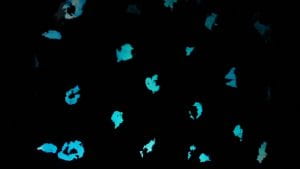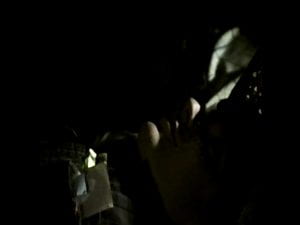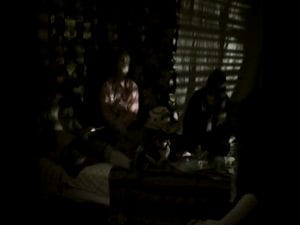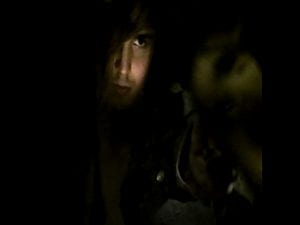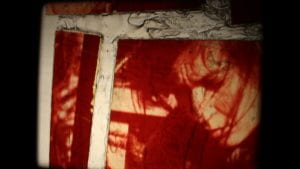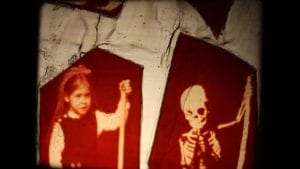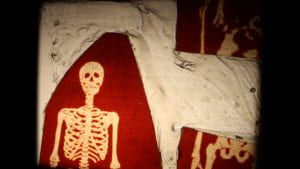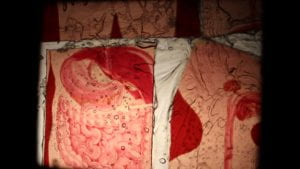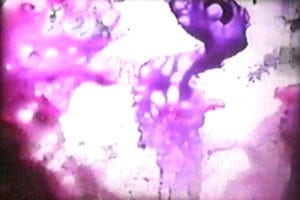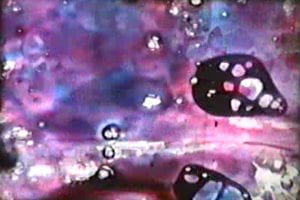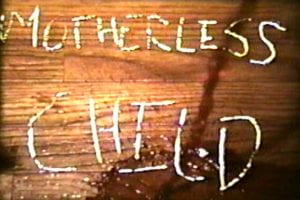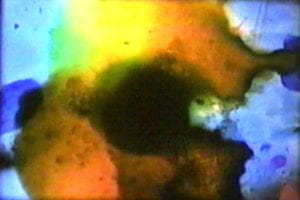
A Place For Film editor Barbara Ann O’Leary chatted this week with experimental filmmaker Matt Lutz, whose work will screen Saturday at IU Cinema during the 2017 Iris Film Festival.
BOL: You have two films in the 2017 Iris Film Festival: Thunderstorm (0:30) and Western Segment (7:19). Can you share a little about the films and how they were made?
ML: Thunderstorm is a direct animation 16mm film. I painted and scratched directly onto blank film in ways resembling the shapes, colors, and movements of a thunderstorm. The thing about animating this way – especially on small gauge film – is that the images are erratic from one frame to the next, it is impossible to get a smooth transition. Our hands are very imprecise, and direct animation exaggerates this unsteadiness, which I find beautiful. I’m interested in taking common occurrences (such as thunderstorms) and filtering them through this process.
Western Segment is a video that sits with a group of indolent cowboy outlaws as they pass time between heists (or presumably between heists – I’m not sure they’ll ever muster the motivation to pull another one). Each character has withdrawn from action to varying degrees: one flips a gun and urges the group to go out heisting, while another sits silent and still for the entirety of the video.
BOL: Am I right that you’ve had work in Iris Film Festival every year for the past 4 years? That’s exciting. How has the Iris Film Festival helped inspire you to continue to create and evolve your work.
ML: Almost! This will be my third year. Last year I was in a bit of a rut creatively and hadn’t made any video or film work that really interested me. But I knew I wanted to submit work to Iris, so I forced myself to produce something new by the submission deadline, and I ended up making Human Body and How it Works, a direct animation film that deals with memory, teaching, and death that I am deeply proud of. That’s a very direct way Iris has kept me making work. But also Iris consistently showcases weird, innovative, and engaging films that I would never be able to find otherwise. A lot of the work other filmmakers have screened at Iris has stayed with me and urges me in more radical and weirder directions in my own work.
BOL: You and I met in Russell Sheaffer’s Super 8 class in 2014. I remember at that time you were exploring hand processing of film, marking and scratching film surfaces, double exposure, and other experimental manipulations of imagery. And I seem to remember you were also working with video. What formats have you been exploring these days? Are there processes that you find particularly compelling for their capacity to convey meaning?
ML: Yes! What a wonderful class! Russell’s Super 8 class is the most important thing that happened to me as a filmmaker – it introduced me to those experimental manipulation techniques and started me thinking critically about film.
These days I’ve been shooting a lot on VHS and other cheap video mediums. I like the harshness of cheap video. It helps to dissociate the work from the real-world. Small gauge film does this in a much more beautiful and magical way, but at a much higher price tag.
BOL: Are there other classes you’ve taken at IU that have particularly inspired you?
ML: I took an invaluable DIY class taught by Russell that kept me working and studying weird processes. I loved shooting and editing on 16mm film in Motion Picture Production. I didn’t take them, but I’ve seen wonderful work come out of Video Art and Video Documentary.
BOL: A few years back when filmmaker Guy Maddin visited IU Cinema, he watched your film Mr. Karate’s Moon Landing and left this comment on your Vimeo channel: “Smart, hilarious, gorgeous, brisk and politically savvy! What atmospheres! Lovely cutting! Congrats! xoxoxoG.” I think you had the chance to meet him in person as well. How has that kind of direct engagement with visiting filmmakers impacted your work?
ML: It was amazing meeting Guy Maddin! I’m not sure if I really have the words to describe how I feel about him commenting on my film and meeting him and seeing his films in such a wonderful setting. Years after and I’m still dazed about it. It certainly boosted my confidence in filmmaking.
BOL: What’s next for you—with your filmmaking, studies, life in general?
ML: I’m in the middle of writing a queer western inspired by Conway Twitty songs. I’m about to start production on a documentary about an elusive retired jazz musician, and there are a couple experimental collaborations in the very early stages. Hopefully one of those will find their way to Iris next year!
BOL: Thanks, Matt. Looking forward to seeing your films and all the rest of the films on the big screen at IU Cinema during the 2017 Iris Film Festival on January 28.
This is Iris Film Festival‘s 11th year running. The festival features work by Southern Indiana Filmmakers. Films compete for the following awards: Best Narrative Film, Best Documentary Film, Best Experimental Film, The Brian Friedman Award and Audience Award. The festival takes place at IU Cinema on January 28, 2017 at 7:00 p.m.
Russell Sheaffer’s On Surgery, co-directed by Aaron Smith, will screen at 2017 Iris Film Festival. His experimental documentary Masculinity/Femininity, shot primarily on Super 8, screened at IU Cinema as a work-in-progress in 2013. Katherine Johnson interviewed Sheaffer last fall for A Place For Film: Experimental Film and Fostering Creativity.
Filmmaker Guy Maddin visited IU Cinema in the spring of 2015 for The Magnificent Cinematic Obsession of Guy Maddin film series, which included a Jorgensen Guest Filmmaker Lecture, and screenings of a number of Maddin’s films.

Barbara Ann O’Leary, Indiana University Cinema’s Social Media and Web Specialist, is delighted to serve as editor of A Place for Film Blog. Barbara’s love of film—particularly the work of women filmmakers—inspired her to launch the #DirectedbyWomen Worldwide Film Viewing Party initiative.
